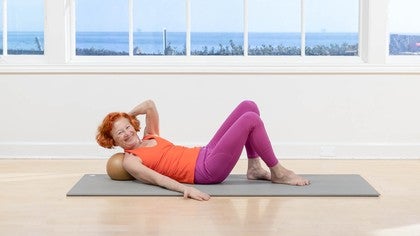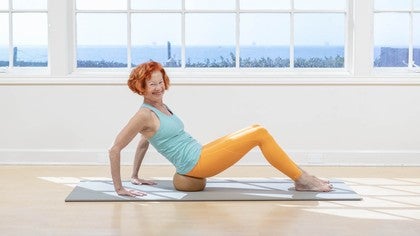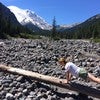Description
Props Needed: White Yamuna USA® Ball or something equilvent
About This Video
Transcript
Read Full Transcript
Welcome. In this video, we're going to be addressing the pecks, this whole front area of the chest which is very key for the trapezius in fact, when you have someone whose shoulders are hiked up and the next is crunched in, believe it or not, this is the culprit very often and you can pull the shoulders back and do whatever you want and it won't really resolve fully. We need this area very broad, very flexible, and very toned in order to support the posture of the body and the verticality of the head. The pecks start in the sternum area and we are going to be softening and working this whole area and lifting it up and then moving out. For the women, we work around the breast tissue.
You want to get into the bones and into the muscle. If you are a guy, you can roll out without any obstruction. For the women, we work around the breast tissue, very important. So we will be working with a medium sized ball and we will start. If you dig into this area, you want to feel where the base of the ribs here, the xiphoid processes.
And we want to go above it. If you feel around with your fingers, there's almost like the beginning of the sternum that's very bony and hard, is that's where we start by placing the ball, and then come onto your stomach and take a moment. Adjust any tissue, breast tissue that you need to, and take a breath in and on the out, breath literally, let yourself drap over this area. That bony area gets very tight and stuck, and we want it flexible and throbbing with life. So you will release down, take a breath.
And as you breathe in, lift your head and chest up and feel how you are pushing the chest forward. The ball will roll down a little bit. And then as you breathe out, you let yourself sink and center and soften over the ball. Again, breathe in. You are lifting the sternum up and away from the stomach area.
And then you are spreading the sternum out as you relax down and curve over. From here, move the body a little bit to the left and roll the ball to the right. So we are tractioning, and if you notice I've grabbed the ball and I'm pulling the tissue of the sternum away. So I'm catching the pecks right where they're attached to the sternum and I'm stretching them. Taking a breath in here, inflate into the ball.
And then as you breathe out, sink down and let yourself soften. One more time, breathe in, push in, press the ball to the right, move your ribs a little bit to the left, and then breathe out and sink down. Come back to the middle and then move a little bit to the left. So now we're grabbing and widening the other side. Take a breath in, lift, rotate slightly and push the ball to the left, breathe out and sink down.
And again, breathe in. Spread that tissue, spread the sternum, and breathe out. Come back to the center and move yourself a little bit higher up. So now you're in the center, maybe a little higher up on the chest, relax down, breathe in, press the ball down as you lift, and then breathe out. And now we'll reverse it.
Breathe in, and as you breathe in, you push the ball up. So we want this sternum area mobile and flexible, and breathe out. And again, you lift up, press into the ball and roll a little bit to the left, dragging the ball to the right. So we're widening that whole front area of the sternum and where the pecks connect in. We're working the attachments.
Breathe out, one more time, drag it and open the right side, rotate a little bit to get more intraction in the area and breathe out, roll the ball to the left. And again, breathe in, traction the ball to the left as you rotate to the right, breathe out, let yourself sink, every time check that you're getting more flexible in the bones breathing in open, and breathe out. Roll a little bit higher up. So you're quite close to the collar bone notch and let yourself drap. Breathe in and push the ball up.
Breathe out. Breathe in and pull the collarbone and the sternum down, and breathe out. Move a little bit to the right so you're catching the collarbone and the sternum and the pecks, that corner area breathe out, one more time, rotate and widen that corner area and breathe out. We'll do the same on the other side, breathe in and rotate a little bit in the opposite direction. Breathe out, sinking in, breathing in, and breathing out.
So we did that start. Now we're going to the, whoops, out part of the ribs. So we're getting to the external section of the pecks. Remember if you are gentleman, you can roll the whole band out in one section, but us ladies have to do it in sections. So you grab under the breast tissue, middle of the ribs on the right side, take a breath in, sink in and feel that pressure and move your body a little bit to the left and roll out.
Remember your widening this whole band of muscle. Then come back, move a little bit higher up, maybe on the bra line. So you want to really dig in on the outside of the breast tissue, take a breath in, breath out, make it work in your anatomy, and then roll a little bit out and relax and move a little bit higher up. So again, you're pulling this tissue out of the way. So you're getting into the rib cage.
Wherever you can, take a breath in, breath out, sink into it. There can be a lot more tightness in this area and slightly roll out towards the armpit, and breathe out, sinking in. We'll do the same on the other side. So left side, you want to be grabbing just below the breast tissue on the left side, take a breath in, breath out, let yourself sink into the tissue and start to feel yourself widening the ribs apart. You're really taking the whole low rib area and you're widening it.
You're widening those pecks out, breath in and start rolling out, one more time, breath in and breath out rolling even further out. So you're expanding that whole band of area. Come back, get just around the bra line, get the tissue out of the way. So you get as much as you can on the bony structure. Take a breath in, breath out, sink into this area and slowly roll a little bit further out to the side, breathing out, relax into it.
And now get even further up. We are getting into just under the armpit area. Take a breath in, breath out, sink into it. This tissue can start to get a lot more tight and congested because we are usually have our shoulders pulled inwards. Start to roll a little bit further out, pressing into this tissue, waiting for that moment where it starts to release.
Then come back and come to the notch under your collarbone. We're actually gonna roll out the bone right there because this is where the pecks connect up. They connect right into the collarbone. So we start right in the notch here. We were here before, sink into this area, lengthen your throat, take a breath in and pull the collar bones down a bit and just lift your chin.
So you're stretching the tissue of the chin away the throat and then sink and move right on the collarbone to the right side. So I move my body to the left. So remember this queue, widen your collar bones. We're doing this by putting the pressure into the bones and starting to soften them and remove adhesions where they can get glued to the ribs. So take a moment here.
This can be more sensitive. This needs a softer ball. You don't wanna be doing in something super hard, and start to rotate out. And you may feel where there are congestions, tightnesses breathing out. You want to wait when you get in touch with spots that are really tight, you just take your time.
You listen in, you allow your body to talk to you. And you let the tissue let go. It will take it. It has its own time. There's no rushing it.
And again, rolling a little bit further out. I've gotten to the point where I've gotten to the notch here. So here's the collarbone, here I am. Now I take the arm out to the side. So my right arm's extended right out to the side to create more traction into this area.
And then as I started roll even further out towards the arm, you want to be sure that the shoulder is pulled backwards. You're not letting it come forward. We want that opening out across this area. So keep expanding the area and then slowly go even further out and rotate as much as you're able to to allow that traction and release to start to kick in. Another breath in, stretch the arm away.
And then as you bring your chest down, feel the shoulder blade pull back. The shoulder blade goes onto the back and the front of the cuff of the shoulder opens up. So let it open, let it open, let it open, let it open, and come back up and we'll do the other side. So start back at the notch of the collar bone. Let's sink down here again, again, lift up and pull the collarbone down.
Feel your neck, stretch a little bit, traction yourself out, then soften into the ball and roll to the right. So the ball is going onto the left collarbone. Take a moment here, sink and relax. See if you can soften the bone, inhale, exhale, sink, softening. This is where the pecks attach right under that collar bone and move more to the right so the ball moves to the left.
Literally feel yourself, widening the collarbone. You're widening all of that tissue, inhale, lift a little bit to get more traction and exhale. One more time, inhale, exhale, sinking and move even more to the right. And now the ball is going to the left, the ball and the arm. So you are taking that whole connection into the arm and you are widening it.
You want to be sure that the whole cuff of the shoulder is to the side and you're not letting it fall forward. You're actually hooking the ball into the cuff of the shoulder and stretching it away from the ribs. Take a breath in and start to rotate a little bit. Make sure that the arm is extending away from you and not rolling and pulling in 'cause that's the pattern. And again, breathing in, and roll into the arm.
Tractioning this whole area and this is where you want to let the shoulder blade sink into the back and the chest really start to open. Let yourself expand into this area and just roll a little bit further out to get as much traction as you possibly can. Keep releasing the tissue, let the arm move away from the body. Let the collar bones open. And then come on off, and just for a minute, let's have you sit up and just check how you feel.
So we did peck major. We still have peck minor and you may be bright red if you've got tight areas and this circulation is open, but you should probably feel this complete opening up of the chest, which can feel wonderful and do take one big breath and just see what that's like. See if there's more movement, and if you can breathe without this happening because you're starting to free up that frontal support. Our next one is peck minor. They attach on the ribs just on the corner here and they roll up in front here and then they attach into the arm bone.
So this area gets very gunky. It's very tight. It's very stuck tissue. So you want to open that as much as you can and sometimes you need to take time with it. So starting on the right side, in the area of your bra line, roll a little bit on a diagonal forward and sink into this area.
So these muscles run one on top of the other. So you often will cross vector them, but the direction of the tissue is different. So you want to sink in, take a moment, feel what you're feeling, start to see if you can differentiate sensation, breathing and expand into the lungs, into the ribs, open things up, pull the tissue out of the way and move up. This is where you will start to get into very tight stuck tissue. This takes time.
So it's not one routine that's gonna release it. Imagine you can have cords and knots and ropey texture in there. And you want all of that juicy and moist and flexible and loose to take your time with this. Big breath, open up as much as you can, move a little bit further down and sink into that tissue a little bit further up. You're grabbing the tissue and you're starting to put pressure into it, letting it release, let it open.
You can move around a little bit, only you know what's going on in your body and you have prime control to release and enter into any part of it. This can become very empowering for you to really become your own therapist. Move a little bit further up. So now I'm catching the front of the deltoid really right where the arm starts, sinking into this area. It's very tight.
Take a moment to really roll around in this area. Any spot that is unique to you, you take a breath, expand it and then get in touch with the feeling. Get in touch with how you can start to separate out this area. You can with your mind and your focus and your attention to start to shift a huge amount. So you want to take this time to very intimately be in touch with the sensations in your body.
Roll a little bit further out into the arm. Take a moment, relax, and let's lie in our backs before we do the other side, just to check in 'cause this usually really changes the arm position massively and opens up and widens the front chest. So just notice a sensation. Notice what's in touch with the floor. Notice what your shoulder blade feels like in relation to the rest of your back, and your neck, very often, the trapezes completely let go when the pecks have been released.
And we will do the other side. So starting out with the left side, bra line area on your side, you want to get into the side and then roll on a diagonal a little bit forward. So you getting into the ribs on that diagonal area, just around the base of your bra line, take a breath in, breath out, start to soften this area. One more time, breath out and drag yourself further down so the ball is rolling up. You can start to stretch your arm out to expose the minor area.
You will start to feel where it's more tight and fibrous and grippy. So just spend time with the sensations in here and see if you can get in touch with letting go and allowing the pressure of the ball to talk to the tissue and start to dissipate the tension. You can imagine it just starting to melt and let go, and spread and soften. Roll further up. So you are in that front area of the tight chest.
This is where it starts getting very congested. Take a breath, really roll out and sink into the area. Again, press and get that arm out sideways now and start to feel the pressure in the high ball area right at the base of the collarbone and that corner, rib cage, collarbone, and arm. And then start to rotate and press into this area. Just feel how you are widening the arm just a little bit further, releasing out.
Take a moment to let that tissue open up a little bit more. You can also move your arm to discover any tight adhesions and knots. This is very much a creative process, any movement that exposes tissue that's tight, go for it. So take one last breath in, breath out. Imagine that arm getting even longer, moving out of the body as you sink down, and then come off the ball.
And again, you will lie on your back and check and see what you feel like. What does your shoulder girdle feel like? How are your shoulder blades on your back? How's the front of your body feel? Can be quite spectacular, the difference in the spine and the whole shape of the ribcage when we open and widen the pecks out.
Bring your subs to a seated position and just check what you feel like, check what your chest feels like. And because we have created this beautiful opening in the chest, we have to do our deltoid, they're this cuff muscle that very often because everything gets tight and pulled up, they pull the arm bone up and into the neck area and they shorten the arm and we have to iron them out, right? Because we want to fully, fully experience the benefits. So for the deltoids, we work with a smaller ball. You can work with a bigger one, but it's nice to have the smaller ball to match the size of the arm.
We will be ironing out the side, the back, the front. This is a short little routine. Again, can make the difference between an arm that's here and an arm that's here where the bone is dropping down long in the socket. So you place the ball right on the side and take a moment to soften into it. This can be surprising how sensitive it can be.
So take a breath. See if you can relax into this area. If you want to, you can always put a pillow or a ball under your head, whatever makes you feel comfortable, take a breath and then iron the muscle down, just really there's not much to it, but you want to feel it going down and long to take a moment, releasing down, relaxing into the area, and then come back. I'll get my little pearl for my head just to show you. Let's see, you will take the ball now, place it in the back.
So we have, and where's my pearl? It ran away. So here we are. I just want to show you, this is a way you can spend more time if you need to. So you support the head.
The head's not part of the action, but you can take time putting pressure into the deltoid, and you can use this in a lot of different positions. So here we go, take a breath in, feel the pressure into the back of the deltoid, and then roll yourself down a little bit and also see if you can pull the shoulder down, and just take a moment resting into the back part. You want to release the muscle down, imagine the ball penetrating all the way into the bone, a bone isn't very big inside there, but there's lots of tissue that we want to get into. Notice if there's some shifts and changes, there probably are. And then come back and put the ball on the front.
So front of the deltoid, grab that tissue. I usually like to press a little bit and externally rotate. So I'm opening that tissue up, but I'm putting the pressure, take a a breath in, breath out. You can sink into it and widen the arm onto the side of the body. Really opening it up, and then drag yourself upwards and let the ball roll down.
Pressing into the arm, pressing into the ball, lengthening the muscle, and then come off and we'll do the other side. So starting out with the ball on the side of the deltoid right there. So you're putting pressure in, you're feeling the arm getting long, you're stimulating the attachment or the origins of the muscle, taking a breath in, sinking and softening the tissue can be surprisingly tight and ironing it out by going down. Big breath in, sink into the ball, finish up that deltoid, roll a little bit lower just to lengthen it out and then come back and put the ball at the back. Take a moment to sink into that back of the tissue, back of the deltoid, keep pressure into it.
Take a breath in, breath out, sinking in, and dragging yourself up so the ball goes down. I'm now lying down on my back, keeping the pressure into the ball and into the muscle. So it's just getting that squeezing action that removes any type dry texture and stimulating it all the way to the bone. Then come off and bring the ball to the front. Lots of moving little movement with the ball, but big changes.
So you place it into the front. Make sure you really get that shoulder pulled out to the side now, take a breath in, press into the ball, breathing out, really compress, feel how the arm will go to the side more and then drag yourself forward, going down that deltoid muscle. And again, paying attention that the shoulder is going to the side and the arm bone's going to the side and you're creating a lot of length in the muscle. One more breath in, breath out, roll it out a little bit more and come off, come up to sitting, check in, your arms may feel much longer, much lower. Your shoulders, check in how do your shoulders feel?
How does your chest feel? How does your sense of being open hearted feel? It's a very interesting you open up this front tissue and suddenly there's a sense of joy in the body. It's not an inflated military chest. It's just a natural state of being where actually you've created spaciousness for the heart and the lungs.
And there's an inner vibrancy that's is hand in hand with being calm and being very present. So I hope you enjoy the feeling. Enjoy the openness. Thank you very much.
Release Your Fascia: Upper Body Freedom
Comments
You need to be a subscriber to post a comment.
Please Log In or Create an Account to start your free trial.











